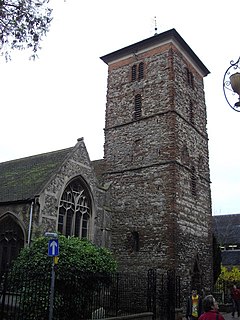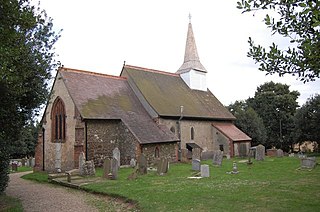
Greensted Church, in the small village of Greensted, near Chipping Ongar in Essex, England, is the oldest wooden church in the world, and probably the oldest wooden building in Europe still standing, albeit only in part, since few sections of its original wooden structure remain. The oak walls are often classified as remnants of a palisade church or a kind of early stave church, dated either to the mid-9th or mid-11th century.

St Augustine's Tower stands in St John's Church Gardens, in Hackney Central, in the London Borough of Hackney, just off the southern end of the Narrow Way. It is all that remains of the early 16th century parish church of Hackney of St Augustine, which replaced the 13th century medieval church founded by the Knights of St John. The Tower comprises four stages beneath a restored parapet with diagonal buttressing. A fine working 16th century turret clock has remained on the third floor of the Tower since at least 1608. The Tower and contents are Grade I listed.

Colchester in Essex, England, has a number of notable churches.

Faversham Stone Chapel also known as Our Lady of Elwarton, is a medieval chapel built on top of a Romano-British mausoleum. The chapel is located in what is thought to have been the Roman settlement of Durolevum, near the modern town of Faversham, in Kent, England. It is the only known chapel in England to incorporate the remains of a pagan shrine or mausoleum.

St George’s Church, Esher is a Grade I listed Anglican church in Esher, Surrey, England. Built in the 16th century, it was Esher’s parish church for 300 years, though later worshippers included Queen Victoria. However, by the mid-19th century the building was deemed too small for the growing population, and was replaced by Christ Church, built nearby on Esher Green in 1853/4. St George’s was not therefore subjected to Victorian ‘improvements’, and its Tudor origins remain evident. It is now cared for by the Churches Conservation Trust.

The Church of St James and St Paul is situated to the south of the village of Marton, Cheshire, England. It is recorded in the National Heritage List for England as a designated Grade I listed building. It is an active Anglican parish church in the diocese of Chester, the archdeaconry of Macclesfield and the deanery of Congleton. Its benefice is combined with those of Holy Trinity, Capesthorne, Christ Church, Eaton, and All Saints, Siddington. The church is an important location in the novel Strandloper by Alan Garner.

The Church of Saint Leonard is a Norman church in Bengeo, Hertfordshire. Located on the hillside overlooking the shared Beane and Lea valley, the Grade I Listed church dates from about 1120, and is the oldest building in Hertford. The church served as the parish church of Bengeo until the larger Holy Trinity Church was opened in 1855. St. Leonard's was stripped of its fittings and stood empty and unused for some years, until the Gosselin family of nearby Bengeo Hall commissioned its restoration and refitting between 1884 and 1894.

St Leonard's Church is in Sandridge, a village in Hertfordshire, England. It is an active Anglican parish church. The building is Grade II* listed: notable features include its chancel arch made from recycled Roman brick.

St Botolph's, Billingsgate was a Church of England parish church in London. Of medieval origin, it was located in the Billingsgate ward of the City of London and destroyed by the Great Fire of London in 1666.

St Mary Magdalene Woolwich is an 18th-century Anglican church dedicated to St Mary Magdalene in Woolwich, southeast London, England.

Little Burstead is a village in Essex, England. It lies 2¼ miles SSW of Billericay, and 4½ E by S of Brentwood railway station.

St Mary's Church is an Anglican church in the village of Slaugham in Mid Sussex, one of seven local government districts in the English county of West Sussex. The 12th- and 13th-century church, restored in the Victorian era, serves a large rural area of the Sussex Weald, covering three villages as well as the ancient settlement of Slaugham. It also controlled the church in the market town of Crawley—now one of the area's largest towns—for the first few centuries of its existence. A locally important family built a private chapel in the church in the 17th century, and a series of memorials to deceased family members are considered to be excellent examples of their type. English Heritage has listed the building at Grade II* for its architectural and historical importance.

St. Peter and St. Paul is a Church of England parish church in the London Borough of Barking and Dagenham, England, formerly part of Essex. It is of medieval origin, largely rebuilt at the beginning of the nineteenth century.

St Andrew's Church is a redundant Anglican church in the village of Willingale, Essex, England. It is recorded in the National Heritage List for England as a designated Grade II* listed building, and is under the care of the Churches Conservation Trust. The church stands less than 50 yards (46 m) from the adjacent church of St Christopher, and shares its churchyard.

St Laurence and All Saints is a Grade I listed medieval church in the parish of Eastwood, Essex, England which has been under threat from plans to expand London Southend Airport.

St Botolph's Church is the Church of England parish church of Hardham, West Sussex. It is in Horsham District and is a Grade I listed building. It contains the earliest nearly complete series of wall paintings in England. Among forty individual subjects is the earliest known representation of St. George in England. Dating from the 12th century, they were hidden from view until uncovered in 1866 and now "provide a rare and memorable impression of a medieval painted interior". The simple two-cell stone building, with its original medieval whitewashed exterior, has seen little alteration and also has an ancient bell.

St Mary's Church, Llanfair-yng-Nghornwy is a medieval parish church in the north-west of Anglesey, north Wales. The date of foundation of the church, which is in the village of Llanfair-yng-Nghornwy, is unknown, but the oldest parts date from the 11th or 12th century. It has twice been enlarged: in the 15th century, when the chancel was rebuilt, and in the 16th century, when a chapel was added to the south of the chancel, separated by three arches. The tower at the west end is from the 17th century. A south porch of unknown date has been converted into a vestry, and the church is now entered through the tower.

St Giles' Church is in the hamlet of Barrow, Shropshire, England. It is an active Anglican parish church in the deanery of Telford Severn Gorge, the archdeaconry of Ludlow, and the diocese of Hereford. Its benefice is united with those of All Saints, Broseley, St Mary, Jackfield, St Bartholomew, Benthall, and St Leonard, Linley. The church is recorded in the National Heritage List for England as a designated Grade I listed building. It is one of the earliest surviving churches in Shropshire, and contains the county's only Saxon chancel.

The Church of St Edward the Confessor is a place of worship in Romford, Greater London. It is an Anglican church and forms part of the Diocese of Chelmsford. The building dates from 1849–50 and replaced an earlier church which was demolished in the mid-19 century. There has been a religious building on the site since the end of the 14th century. The current church was completed to a Victorian Gothic design by the English architect John Johnson. It was designated as a Grade II* listed building by English Heritage in 1952.

The Church of St Katharine of Alexandria is the Church of England parish church for Ickleford in Hertfordshire. It is a Grade I listed building and comes under the Diocese of St Albans.
























